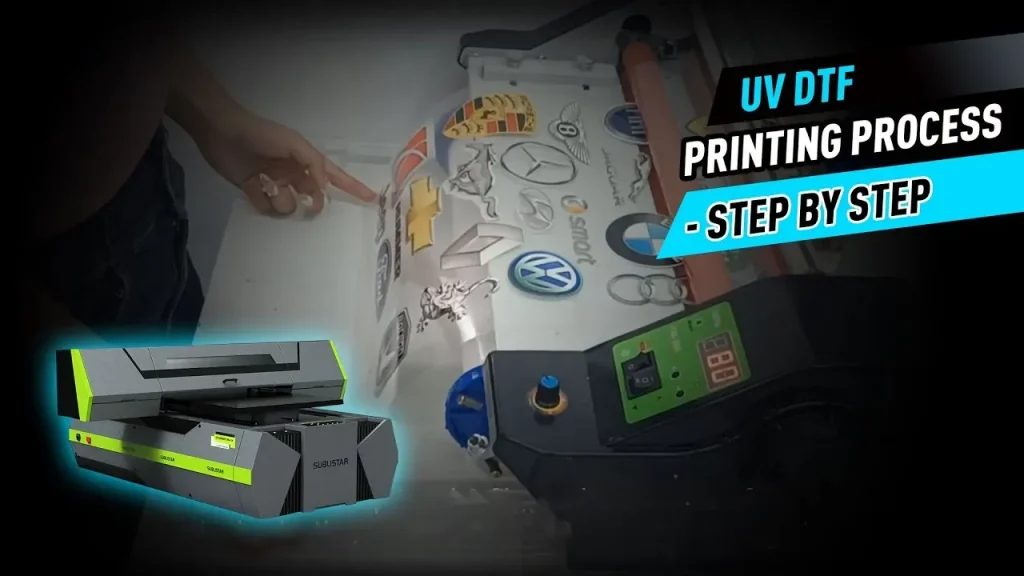The UV DTF printing process is revolutionizing the world of digital printing by merging innovative technologies with functionality. As businesses shift towards more efficient printing solutions, understanding how UV DTF printing works is vital for staying competitive. This technique utilizes UV printing technology to produce high-quality images with vibrant colors and impressive durability, making it a preferred choice for various applications. From the initial design creation to the final quality inspection, each step in the UV DTF printing guide is crucial for delivering top-notch printed products. With numerous benefits of DTF printing, including versatility across substrates and resistance to environmental wear, it’s no wonder this process is gaining popularity.
Known as Direct to Film printing, the UV DTF printing technique offers a contemporary solution for those seeking high-resolution designs with lasting impact. This cutting-edge method combines traditional and digital printing practices, allowing for prints that are not only visually stunning but also exceptionally resilient. Leveraging advanced UV ink technology, this printing approach ensures deep color saturation while preserving the integrity of the material. As you explore the intricacies of this remarkable printing process, you will uncover the essential steps involved, ranging from film preparation to intricate curing methods. Ultimately, UV DTF printing opens up new avenues for creativity and product durability in the competitive printing marketplace.
Understanding the UV DTF Printing Process
The UV DTF printing process is a sophisticated method used in the printing industry that combines direct-to-film technology with ultra-violet curing. This innovative technique allows for printing high-quality, durable images onto a wide array of materials, which has become particularly advantageous for businesses looking to expand their product offerings. By leveraging UV printing technology, businesses can achieve vibrant colors, intricate designs, and high-resolution prints that stand out in the competitive marketplace.
In essence, the UV DTF printing process involves the creation of a design that is subsequently printed onto a transfer film with UV inks. The application of UV light cures the ink almost instantly, resulting in prints that are not only visually appealing but also resilient to various environmental factors. This integration of advanced printing techniques has revolutionized the industry, making UV DTF printing a preferred choice for many professional printers.
Key Benefits of DTF Printing Technology
One of the primary benefits of DTF printing technology is its versatility, as it allows for creations on diverse substrates, including textiles, plastics, and even wood. This adaptability makes it highly favored in industries ranging from fashion to promotional products. Additionally, the prints produced through DTF possess vibrant color profiles that can elevate products and attract consumers, proving successful for businesses seeking to capture attention in today’s visually driven market.
Durability is another significant advantage of DTF printing technology. UV-cured prints are not only waterproof but also resistant to abrasions and fading, ensuring that designs remain intact even under harsh conditions. This inherent durability is critical for products that will experience high levels of use, making UV DTF prints ideal for items like outdoor gear or custom apparel, which demand longevity and quality.
The Step-by-Step Guide to UV DTF Printing
For those interested in adopting UV DTF printing, understanding the step-by-step guide is essential for ensuring quality output. The process begins with design creation, where graphic design software is employed to produce high-resolution images. Following design preparation, the film is printed using specialized printers equipped to handle UV inks—ensuring that every detail is vivid and sharp. By adhering to precise techniques during the initial stages, printers can set the foundation for a successful print run.
After film preparation comes the ink application, which is crucial for achieving the desired print quality. As the UV inks are applied, they cure instantly under UV light, resulting in prints that exhibit enhanced vibrancy. Finally, the curing and transfer processes solidify the design onto the chosen substrate, with careful attention paid to factors such as pressure and heating requirements, according to material specifications. This structured approach helps to mitigate errors and ensures each print meets stringent quality control standards.
Advancements in UV DTF Printing Technology
The field of UV DTF printing is continually evolving, with rapid advancements that significantly enhance the efficiency and quality of prints. Innovations in curing technologies have allowed for quicker drying times and improved ink formulations, which increase flexibility and adhesion on a wider range of materials. These advancements not only benefit small businesses looking for agility in production but also cater to large-scale industrial operations requiring consistency and reliability in their print outputs.
Understanding these advancements is crucial for businesses looking to implement UV DTF printing technology. Staying updated with the latest trends allows companies to refine their practices and ensure they are making the most of new developments in the field. Embracing such innovations ultimately empowers businesses to remain competitive in a dynamic market and consistently deliver exceptional products.
Quality Control in UV DTF Printing
Quality control is an integral part of the UV DTF printing process, ensuring that every printed design meets customer expectations. After the printing is complete, it is essential to conduct thorough inspections to detect any defects, such as color discrepancies or misalignments. This step not only validates the quality of the prints but also helps pinpoint any necessary adjustments in the printing process, leading to continuous improvement.
Moreover, post-printing finishing tasks, including trimming and cutting, further enhance the quality of the printed product. By implementing robust quality control measures, businesses can guarantee that their final output is pristine and ready for distribution. This focus on quality is essential for maintaining customer satisfaction and fostering repeat business, highlighting how vital it is to invest in both the technology and the process.
Emerging Trends in UV DTF Printing
Keeping an eye on emerging trends in UV DTF printing is crucial for industry players. Currently, the market is witnessing a surge in demand for eco-friendly printing solutions, leading to the development of environmentally friendly inks and substrates. As consumers become increasingly aware of sustainability, businesses that adopt these trends can position themselves favorably in the market, appealing to a broader range of customers who value sustainability.
Additionally, the integration of digital technologies, such as automation and artificial intelligence, is transforming how UV DTF printing operates. These digital innovations streamline processes, reduce waste, and improve production speed, allowing businesses to meet tight deadlines without compromising quality. Staying ahead of these trends ensures that companies remain competitive and benefit from the advancements shaping the future of printing technology.
Frequently Asked Questions
How does the UV DTF printing process work?
The UV DTF printing process starts with creating a high-resolution design in graphic design software. The design is then printed on a transfer film using UV inks. After applying a UV-curable primer for enhanced adhesion, the ink is cured quickly under UV light, which locks in vibrant colors. Finally, the cured film is transferred onto the desired substrate using a heat press, ensuring exceptional durability and color quality.
What are the benefits of UV DTF printing compared to traditional methods?
UV DTF printing offers several benefits over traditional printing methods, including superior ink adhesion, vibrant colors, and durability. This process produces both waterproof and scratch-resistant prints, making it perfect for a wide range of substrates like fabrics, plastics, and ceramics. Additionally, the rapid curing process significantly reduces production time and allows for intricate designs.
Can UV DTF printing be used on any type of substrate?
Yes, UV DTF printing is highly versatile and can be used on various substrates, including fabrics, wood, metal, and plastic. The unique properties of UV-cured inks allow them to adhere effectively to different surfaces, making it an ideal choice for custom printing projects across multiple industries.
What are the steps involved in the UV DTF printing guide?
The UV DTF printing guide involves several key steps: 1) Design creation using graphic design software, 2) Film preparation with UV-curable primer, 3) Ink application using UV inks, 4) Curing under UV light, 5) Transfer to the substrate with heat press, and 6) Final curing and quality control to ensure the best print quality.
Is UV printing technology eco-friendly?
UV printing technology, including UV DTF printing, is generally considered more eco-friendly than traditional printing methods. The UV curing process eliminates the need for solvents and VOCs, reducing environmental impact. Additionally, UV inks often contain fewer harmful chemicals, making them safer for both printers and the environment.
What tools and materials are necessary for UV DTF printing?
To set up UV DTF printing, you will need a compatible printer that supports UV inks, transfer film, UV-curable primer, heat press, as well as graphic design software for creating designs. Quality UV inks and curing lamps are essential for achieving vibrant and durable prints. Adequate workspace and safety equipment are also recommended.
| Step | Details |
|---|---|
| 1. Design Creation | Begin with a high-resolution design in CMYK mode using graphic design software. |
| 2. Film Preparation | Print design onto transfer film, applying a UV-curable primer for better ink adhesion. |
| 3. Ink Application | Apply specialized UV ink to the film, which cures rapidly under UV light. |
| 4. Curing Process | Pass the printed film through a UV light source to cure the ink instantly and enhance durability. |
| 5. Transfer Process | Use a heat press to apply the cured film to various substrates. Adjust pressure and temperature for optimal results. |
| 6. Final Curing | Additional UV light may be applied after the transfer process for complete ink curing. |
| 7. Quality Control and Finishing | Inspect prints for defects and perform necessary finishing tasks before distribution. |
Summary
The UV DTF printing process showcases a revolutionary approach in the printing industry, guiding users through essential steps from design creation to quality control. This method allows for high-quality, durable prints across a myriad of materials, catering to the evolving demands of consumers and businesses. With its versatility, efficiency, and the ability to produce vibrant images, UV DTF printing not only elevates product offerings but also meets the rigorous standards necessary for today’s competitive markets. As such, understanding the UV DTF printing process and its benefits is crucial for any enterprise aiming to thrive in this dynamic landscape.



